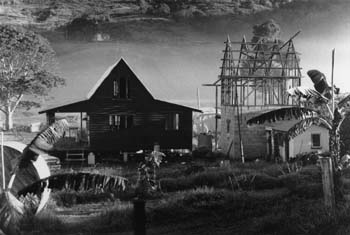 | |
|
Owner built house, Mullumbimby | Multiple Occupancy Since the early 1970's the North Coast has experienced a steady stream of 'new settlers' escaping the stress and pollution of the urban centres, seeking a healthier and more fulfilling rural lifestyle. Many have chosen, through economic necessity or for ideological reasons, to share land and live in varying degrees of communality in the country on Multiple Occupancies (MO's) MO's have provided the opportunity for many to build their own houses, an opportunity they would not have had in the cities. This new lifestyle is reflected in the profusion of innovative dwellings, in their form, use of materials and construction methods. As banks will not advance building loans to MO residents because they don't have title to their individual building blocks, owner-builders have had to rely on their own resources, labour and ingenuity to house themselves. While this has often been a severe limitation on the building budget, it has had the advantage of freeing them of the constraints and conformity imposed by lending authorities. A number of features distinguish most MO dwellings from mainstream suburbia, apart from their rural and bush locations. In many cases, buildings evolve in an organic way taking years to complete, with finishes and rooms added as necessity demands and finances allow. Often materials that are readily available in the locality are used, such as bush poles for pole frame houses, local stone, and numerous examples of home made mud bricks used for walls and even for floors. The popularity of this material has been responsible for the establishment of a small mud brick making industry. Rammed earth wall construction is another variation on this theme. Many MO dwellings reflect an awareness of the need for building to be ecologically sustainable. High energy consuming and polluting materials are avoided and 'natural' non-toxic materials are used wherever possible. The first composting toilets on the North Coast were constructed on a Terania Creek MO. Composting toilets are now gaining widespread acceptance as an effective solution to pollution problems experienced with conventional sewerage treatment. Another common feature of MO dwellings is their integration into the site through landscaping and plantings. Often the layout of the site is based on permaculture principles, where the house, gardens and animals are parts of a self-sustaining system. MO's continue to promote permaculture to the public at large. Because MO's are often located too far to connect to the electricity grid, houses are equipped with solar, hydro and wind power, thereby assisting the development and growth of the alternative energy industries. Awareness of energy use also encouraged the use of passive solar design in the planning of buildings. MO's have made, and continue to make, an invaluable contribution to the provision of creative housing solutions which address some of the environmental, economic and social problems facing society. Edwin Buividis, architect, Lismore Echo, August, 1994 |
